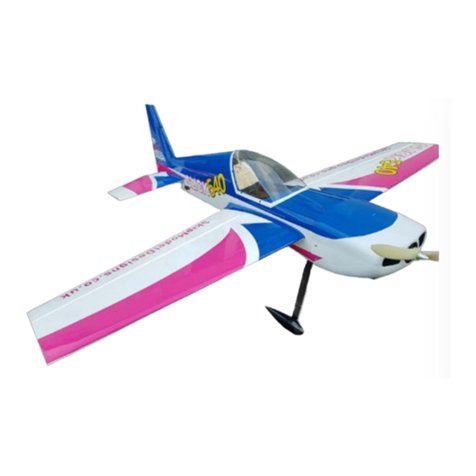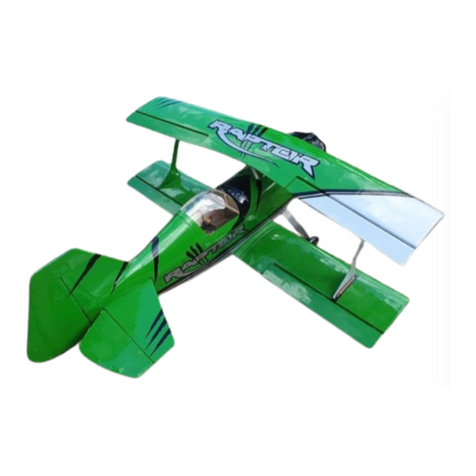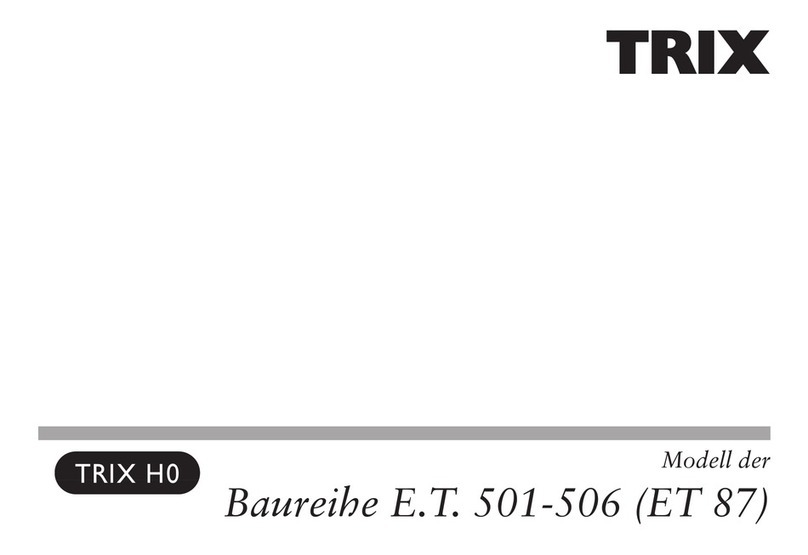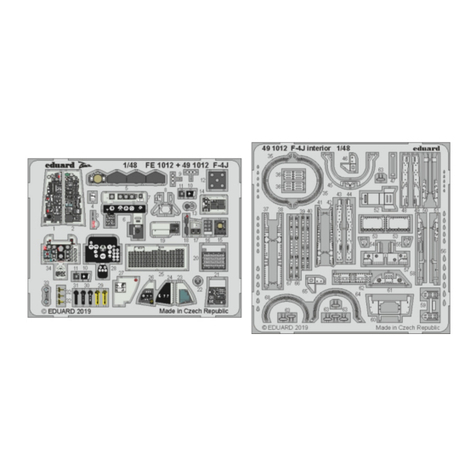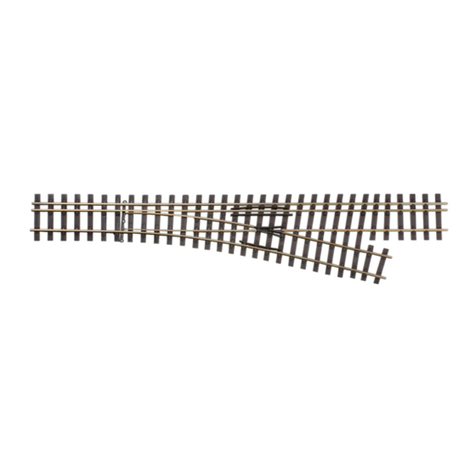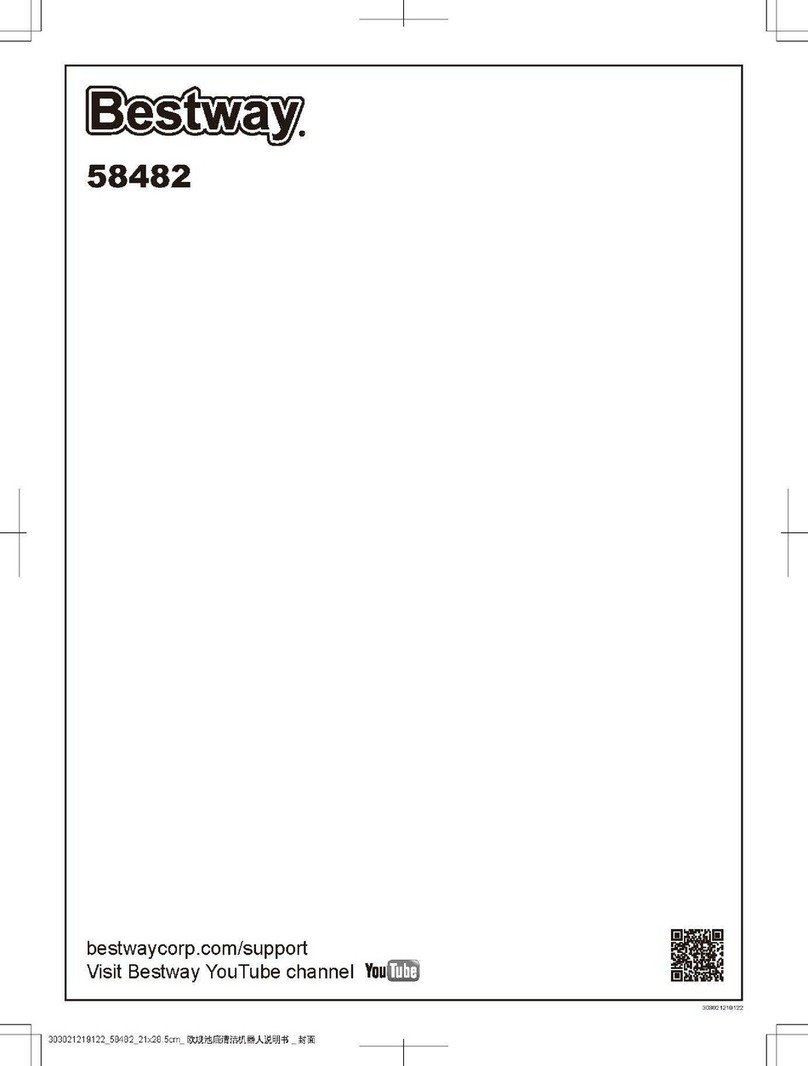Skip Model Designs 41% Ultimate 10-300 User manual

41% Unitmate 10-30041% Unitmate 10-300

Thank you for purchasing the Skip Model Designs 41% Ultimate Biplane.If you have any issues,
questions, concerns or problems during assembly, please contact us :
Hello @skipmodeldesigns.co.uk
SAFETY in Assembly
During assembly of this aircra, you will be asked to use sharp knives and hobby adhesives. Please follow all safety procedures recommended by the
manufacturers of the products you use,and always follow these important guidelines:
• ALWAYS protect your eyes when working with adhesives, knives, or tools, especially power tools. Safety glasses are the best way to protect your eyes.
• ALWAYS protect your body, especially your hands and ngers when using adhesives, knives, or tools, especially power tools. Do not cut toward exposed skin with
hobby knives. Do not place hobby knives on tables or benches where they can roll o or be knocked o.
• ALWAYS have a rst-aid kit handy when working with adhesives, knives, or tools, especially power tools. ALWAYS keep hobby equipment and supplies out of the
reach of children.
• SAFETY in Flying! is is NOT a toy! It is a very high-performance RC airplane capable of high speeds and extreme manoeuvres. It should only be operated by a
competent pilot in a safe area with proper supervision.
• ONLY y your aircra in a safe, open area, away from spectators and vehicles and where it is legal to y. NEVER y over an unsafe area, such as a road or street.
• NEVER y near overhead power or utility lines. If your airplane ever becomes stuck in a line or a tree DO NOT attempt to retrieve it yourself. Contact the authori-
ties for assistance in retrieving your aircra. Power lines are DANGEROUS and falls from ladders and trees CAN KILL!
• Never y too close to yourself or spectators.
• Spinning propellers are DANGEROUS! Never run your motor inside a house or building with the propeller attached Remove the prop for safety. • • • Always y
within your control.
• Always follow manufacturers instructions for your radio system.
•Always preform a pre-ight check of your aircra to be certain of the aircra’s airworthiness.
•Always obtain proper insurance before ying. Always y model aircra in accordance with the Academy of Model Aeronautics (AMA) Safety Code and BMFA/
LMA. Please visit ese websites easily found in major search engines.
Limits of Responsibility
Skip Model Designs provides high-quality aircra and components to it’s customers and end users. ese aircra and components are assembled by the end user to
produce a ying model. It is beyond skip model design’s to monitor the end user’s completed aircra. erefore, Skip Model Designs in no way accepts or assumes
responsibility or liability for damages resulting from the end user assembled product. e end user assumes all responsibility and liability in use of Skip Model
Designs and components
Required Items
• Masking or painters tape
• Various Balsa woods detailed in the Packing Sheet
• Various Carbon Fibre Rod
• Various Sized, Nuts, Bolts and General Building Supplies
• Hobby knife with #11 blades.
• Fresh 30 minute & 15 Minute epoxy.
• Plenty of both Medium and in CA.. Activator can also be used.
• Electric drill with an assortment of small drill bits.
• Small at head and Phillips head screw drivers.
• Standard and needle nose pliers.
• Hammer, Hacksaw and other basic Hobbiest Tools
• Metric ball driver or allen key set.
• Sanding block and sandpaper. Hobby Plane
• 7 x Hight Torque 30kg Servoc
• 5” Spinner
• 120CC Sized Gasoline Engine
Make sure that the plane is secured properly when you start up the engine.
Have at least 2 helpers hold your plane from the tail end or from behind the
wing tips before you start theengine. Make sure that all spectators are behind,
or far in front, of the aircra when running up the engine.
Make sure that you range check your R/C system thoroughly before the rst
ight. It is absolutely necessary to range check your complete R/C installation
rst WITHOUT the engine running. Leave the transmitter antenna retracted,
and check the distance you can walk before ‘fail-safe’ occurs. en start up
the engine, run it at about half throttle and repeat this range check with the
engine running.
Make sure that there is no range reduction before ‘fail-safe’
occurs. Only then make the 1st ight. If you feel that the range with engine
running is less then with the engine o, please contact the radio supplier and
the engine manufacturer and DON’T FLY at that time.
Check for vibrations through the whole throttle range. e engine should run
smoothly with no unusual vibration. If you think that there are any excessive
vibrations at any engine rpm’s, DON’T FLY at this time and check your engine,
spinner and propeller for proper balancing. Due to the models construction
( Been Light) it is very important to have everything running smoothly

Elevator and Stab Assembley
With Any model build, It is important to test t components
together before gluing ( Where applicable). 5 Minutes test
Fitting can save hours of Unpicking.
To build ANY COMPONENT of this model, Please make
sure you have a large enough area to work safely, and that
your work bench for the next few months is clean, tidy and
most importantly FLAT
First Part of the build is the elevator and Stab( e most
simple parts to build on the model)
Inside the kit you will nd 4 Parts which are made from
3mm Poplar Ply ( ey look like the attached picture In
Shape)
ese are the cores of the elevators and stab.
--------------------------------
To Begin the build, Put all the parts at on a Board and
nd the 6.5mm x 9.5mm Balsa Strips and the 6.5 x 9.5mm
Spruce strips
When building the elevator and stab. You have to do 1 side
of the elevator and Stab at a time ( DO NOT, Keep turning
the parts over as this could warp the elevator and stab)
e spruce strips are for the REAR of the elevator Stabs
& rudder n..
********** PLEASE READ THIS PART BEFORE BUILDING
TO MAKE A DECISION*****************
We recommend you glue the spruce with 30 minute Epoxy.
1 Strip of 6.5mm x 9.5mm Spruce will do both sides of 1
Stab. Glue the 6.5mm x 9.5mm Spruce Strip upwards,
so that the 6.5mm Side sits at to the 3mm Core.
Aer you have glued the spruce to the rear of the stab, It
is the matter of cutting and Sticking the Balsa Strips to the
Stab and elevator...... We used Super-glue for this. Again
the 6.5mm Side of the Balsa sits at on the core
Please Glue all Balsa wood to the elevator and stab Like
image shown
------------------------------
We have marked on the Plywood core where the
reinforcement blocks are to be placed for the Steelwork and
Horn Blocks and also the rear tube support. ese are made
a balsa sandwich. 6.5mm then a piece of 3mm Ply..
-----------------------------------------
Once one side of the elevator and Stab is complete, ip the
elevator and stab over and repeat the entire process again
ensuring the elevators are kept at.
-------------------------------------
When the Elevator Stabs are complete, Drill the Holes in the
Steel work Reforcement Areas with a 3mm Drill
Please note: Servos t in Stabs on production models

e Front of the Elevator is to have a 45% chamfer
to each side. is will give you 45 Degrees Of Move-
ment, Please Adjust to your Flying Style, But we do
not recommend more than 50 Degrees or less than
30 Degrees. as this is a very sensative surface.
--------------------------------
e Hinges for the Elevators are Made by Robart.
Simply drill throught the pre market holes and test t
the hinges in place at this point. Do not glue in place.
is wil be done at the nal t of the model aer
covering
--------------------------------
Drill through the Balsa wood mating surface on the
elevator stabs and Insert the 8mm Carbon tubes in
to the designated cut outs on the elevator stabs and
holders.
.. ese are glued in place with epoxy..
Ensure a good glue joint between the elevtor stabs
and the Carbon, We recommend gluing both sides to
ensure a strong bond
ese act as the antirotation pins on elevators.
Trim o any excess by simply sanding this o.
---------------------------------------
e Elevator Servo blocks are made from 6mm
ply ( S1,S2 & S3) there orientation is shown the
the photos use Epoxy to glue in place. At this
point we recommend test tting the servos and
drilling the Blocks as it will make it easier to
assemble the model later.
A Small Hatch will need to be made which sits
on the outside of the model to access the servo
from the underside when covered
e Elevator Front edge is made up by gluing a
strip of 6.5mm Balsa to the front and rouning.
ere are 2 areas that a required rounding
Front Edge of elevator stabs and the Triangle
face of the elevators, as shown in the image
At this point the elevators and stabs can have a
pre-nal sand as they are complete.
Next Up Rudder and Fin
Round

Rudder Assembley
Construction is similar to elevator using the same
6.5mm x 9.5mm Spruce and 6.5mm x 9.5mm Balsa.
However, the Rudder and Fin is only 16m ick, So
the orientation of the Balsa and Spruce changes tro
lye on the 9.5m Side. nished thickness is 16mm
e Fin Rear is to have the Spruce Glued to it with
epoxy. Do NOT CUT EXCESS OFF. You will need
approx 250mm to extend past Fin at bottom which
will t in to fuselage later ( Please see photo for
reference of what me mean!)
Please note : At base of Fin there are 2 holes of 8
mm diameter, these correspond to the holes in
horizontal stab set to 1.5 degrees of incidence. It is
important you drill
these holes as you cover them with balsa strip
otherwise you will loose location of rear stab
------------------------------------------------
e Blocks for the Rudder and steel work are pre-
made from 6mm Balsa ply and 3mm Ply


Fuselage Assembley
In e fuselage, You will nd alot of parts Labled
with acronym’s. Once you get the hang on how
they are labled, and meanings like SD ( Servo
Doubler), MUCP ( Main UnderCarriage Plate) it
will be easy.
So you have built the elevators and rudder?
Congrats.. If not... Go back and start the build
with easy parts :D
e fuselage is relatively Simple....... Other than
the front end of the fuselage... PLEASE be very
patient when building the front end
of the model!. All Parts DO go together.. But are
an extremely good t.. You will require a Rubber
Hammer
We could have made this part a little sloppy going
together,
however, all the forces of the undercarriage, Wing
wires and engine all go through these parts!.
We accept everyone will curse us when putting
this together!..... But its for the good of the model!
e rst 5 ribs are a while away...So lets start o
with some easy bits rst.
------------------
First of all. You need to join a few parts of the
fuselage together.
Fuselage Top ( 3mm Ply).
e fuselage top can be glued together with
Superglue or epoxy, the choice is yours.

Ok.... So we may have lied about not doing the rst
4 ribs rst, We thought we would put your mind at
ease...... en Jump Straight in to it!..... Element of
surprise :)
With the model been built upside down,
this ensures the entire plane is built true and
straight.
We will do this as numbers to make it a little easier
to get the grasp of
1) Add the 2 fuselage Sidesto the Fuselage top.
ese need to be glued using 30 minutes epoxy Or
longer if you are unsure of your building speed as
all the following steps need to be done at once! Use
epoxy throughout
2) Add e Fuel Tank tray
3) Add F4
4) Slide in F3, test t this before gluing as it may be
a little tight, Simply le or sand the mating faces. A
rubber happer is useful on the.
5) Add F2 Using the same principle as above.
6) Add F5, Using the same as above
7) Add FB between F4 AND F5
8) Add the F4B to the Wing Flair.
Before continuing, this will all need to dry.
** As a note, Make sure to wipe all excess glue o.

Once the fuselage is dried, you now need to add
the undercarriage Side doubler, Undercarriage
Doubler and Main UC Plate. Use 30 Minute
Epoxy,
Before Gluing the Main UC Plate in place. Make
sure the Undercarriage doubler is covered with
epoxy.
Use weights to hold in place while it id drying.
Next is add F1. is is where the Rubber
hammer comes in handy
With the front of the fuselage over the bench,
Dry t F1 to the Fuselsge, you may need to
chanfer all mating faces to get to go in place.
Once you are happy with a rm t. Remove F1
And Add glue to all mounting Faces. Allow to
fully dry before moving.
Image Shows Undercarriage Doubler which ts
on the inside of the model
.
Image Shows Undercarrage Plate.

Leave F1 Hanging over the edge of the
deck and now add all other fuselage ribs
* F6 - F9 - Ensure these are square to
fuselage, use super glue to stick in place.
e Following needs to be glues with
epoxy
* Rear UC Sides
* Rear UC Plate
* Rear UC Sides Reinforcement plate (
Show in image)
With all the Ribs in place, it is now time
to add the 1830mm Obechi Strip to the
Fuselage.
Only 3 of the 5 Pieces run the entire
length of the fuselage.
Use epoxy through out putting the strips
in place.
1 & 3 run Full Length of the Fuselage
2 Run from rear of fuselage and
terminate at F4 ( Area shown in photo)
Please ensure no3 Runs under the Rear
UC Plate and is glued with epoxy. Make
sure to get a Hard t against Rear UC
Sides and Rear UC Plate.
1
2
3
2

Fit e 5mm x 9.5mm Balsa wood Stringers
to the Fuselage. You will need to join these
with a scarf joint. Use Superglue to a good
strong bond. Ensure these run in to the Rear
UC Sides. We recommend adding a joining
strip inside the rear UC area
Dont Forget to add me hidden here :)
ese Balsa Stringers are only between
F2 AND F4B. Where is stringer Meets
F4B you will need to sand to make a
good t. Superglue in place
e Exhaust Hatch can now be added to
the model by using scrap pieces of wood
for screw points in each corner

e Phenolic tube can be added to the
model. You will need to notch the Obechi
Middle Strip to get the
Phenolic in place.
Glue in place with Epoxy.
Add FLWM to the Fuselage Sides.
Aer all of this is done and Glues, You
can now ip the model over and take a
look at your lovely Boat Hull..... Did we
not say, were making an ultimate boat :)
Now we can gain access from above, we
can now add the servo tray. Use epoxy on
all mounting surfaces.

FT2, F3T AND F4T Can be glued in
place Using epoxy.
You can also at this point add TWM
Rear Turtle Deck Ribs can also be added,
use CA to get the angle of F6T Correct.
ese Can be glues with Superglue.
Do Not Place F9T in Place Just yet
e Rudder Stab Can be added to the
fuselage. is interlocks in to F8T.
e 2 pieces of Spruce from the Rud-
der n will need to be cut to length and
Shaved slightly to get to t in the Rear
Undercarriage Sides.
Ensure the rudder stab is at 90 Degrees to
the model.
Use Epoxy to glue in place, ensure a hard
t!

A small Strip of balsa wood can be glued
between the spruce on the stabs.
Superglue will be perfect for this.

In the Kit, there is also 4 Parts Called STM. ese
parts are used to set the Elevator Angles
Put the 8mm Carbon through the Stab AND
through STM Both Sides.
In the Kit you will also nd 2 x Alignment tool
for the Elevators. is is placed against F8
With all 4 STM and e 2 x Alignment tool in
place. is should align the elevators perfectly
Tac Glue STM in place with super glue. e Tool
can now be removed.
It is now worth sliding both elevators on the the
model to ensure they t correctly.
Trim the 8mm carbon ush with the Rear UC
Sides.
Slide in the 6mm Carbon Tubes and slide the
elevators in to place.
You will need to cut down the 6mm carbon to
size so that that they t the fuselsge and Tails
correctly.
Take Measurements from 2 known
places to ensure the elevators are the same.
Once satised that everything is correct. STM
Can now be perminantly glued in place.
F9T can now also be glues in place.

Aer the elevators are mounted correcly, e
4mm x 4mm Stringer can now be added to the
rear turtle deck! Superglue is ne for this.
At the point your fuselage should now look like
this :)
Assemble the engine box using epoxy., Make sure
the engine box has right hand thrust ( Like the
shown photo)
When the box is assembled, Epoxy all mating
faces and t to F1. ere are also T Key and B
Key to add ( See image) ese are to be ham-
mered up for top location tab, and down for bot-
tom tab from behind F1. is secures the Engine
box to F1. Use Epoxy to glue in place.

on F4 and F2 you now need to add the steel work
for the wings, these are in the Ali Pack supplied
with the Kit. ON F4 AND F2 the ali ts in the
same place. as shown on drawing,
e Rear UC Steelwork location is shown on the
plans
Once these are in place, we are up to sheeting the
model :)
e Rear of the fuselage is sheeted with 2.4mmb
balsa like the image shows. We prefer to Wet the
balsa and use white glue. To keep the shape, we
use string to pulled tight to hold in place while it
dries.
Ensure you cut the balsa around the rear Elevator
Carbon Rods.

ere are also a few other areas at the bottom of
the model that will need sheeting to make things
neat for covering and Rudder Control Wire Exits.
Underside sheeting

Continue to sheet the model in 2.4mm balsa as
the photos show.. DO NOT SHEET THE FOR-
WARD TURTLE DECK JUST YET,
Please note, you will need to make a llet here
that blends in to the UC plate.
is is quite dicult to do as it has to prole the
wing shape as well.
please take your time while doing it.
You do not need to do this llet, you can simply
add a block and shape to wing air shape, is is
A cosmetic Shape and only if you want scale is it
to be done..

Once sheeted, Give yourself a pat on the back! your fuselage is nearly complete. Next we move on to wings
which are a total plan build. Dont worry, Most of the hard work is now done.
e Cockpit frame can now be assembled on the model,
We recommend using greese proof paper, so it does now
stick to the model.
Balsa stringers are to be added in the designated places
on formers, proir to sheeting,
All of the cockpit frame can be assembled with superglue
e Cockpit frame is sheeted as shown in the image. Use 2.4mm Balsa
As a Tip. We recommend building the top wings as one, this helps with getting the wings identical. If you
cannot do this, then please make Jigs on the plans to ensure they are build accurate
Other Skip Model Designs Toy manuals
Popular Toy manuals by other brands
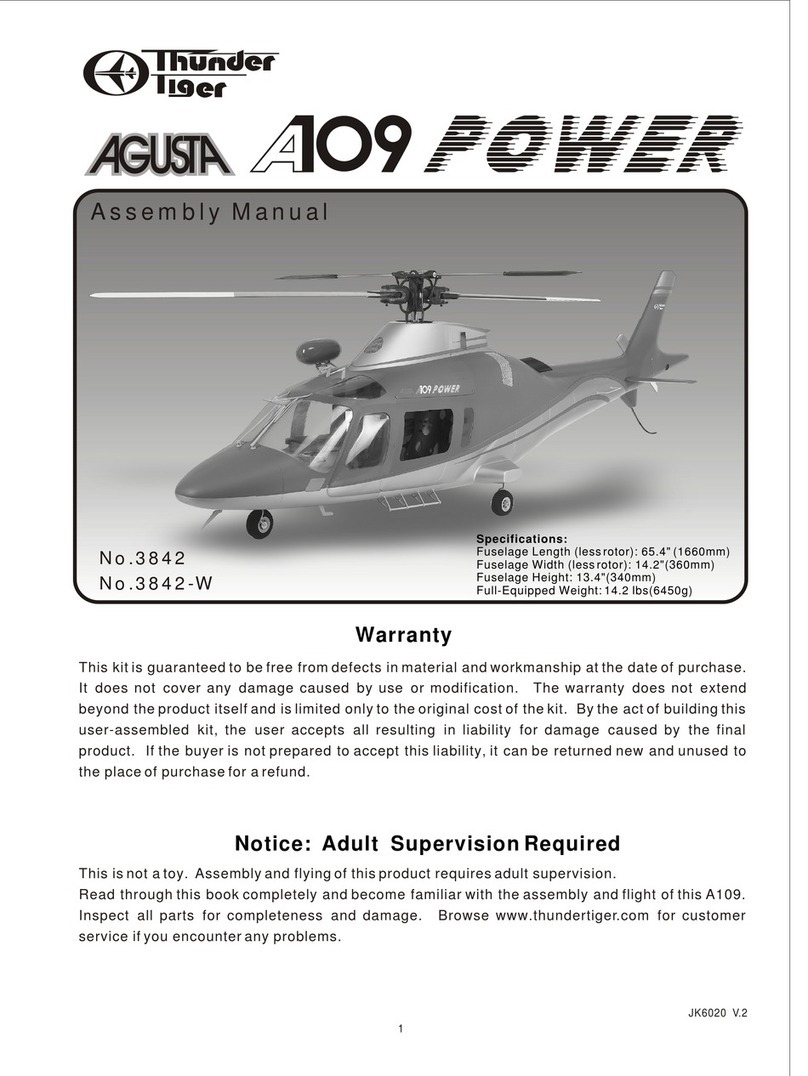
THUNDER TIGER
THUNDER TIGER Agusta A109 Assembly manual
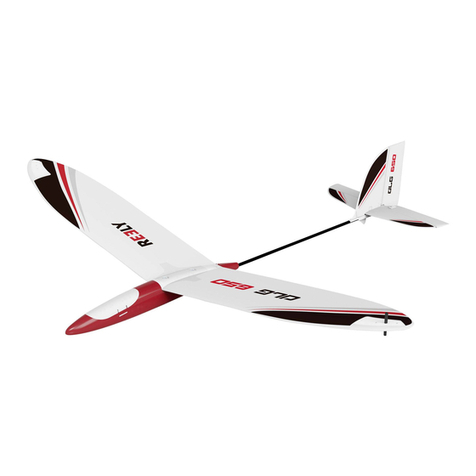
Reely
Reely DLG 650 RC operating instructions
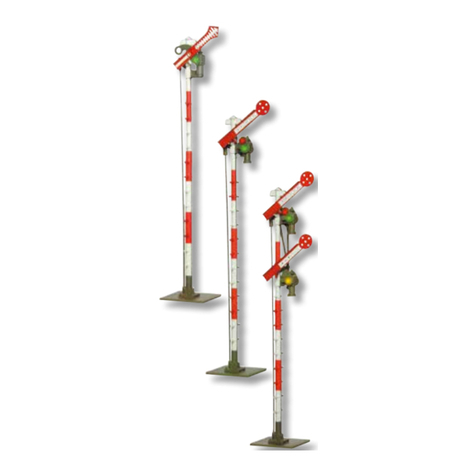
Viessmann
Viessmann 4507 manual
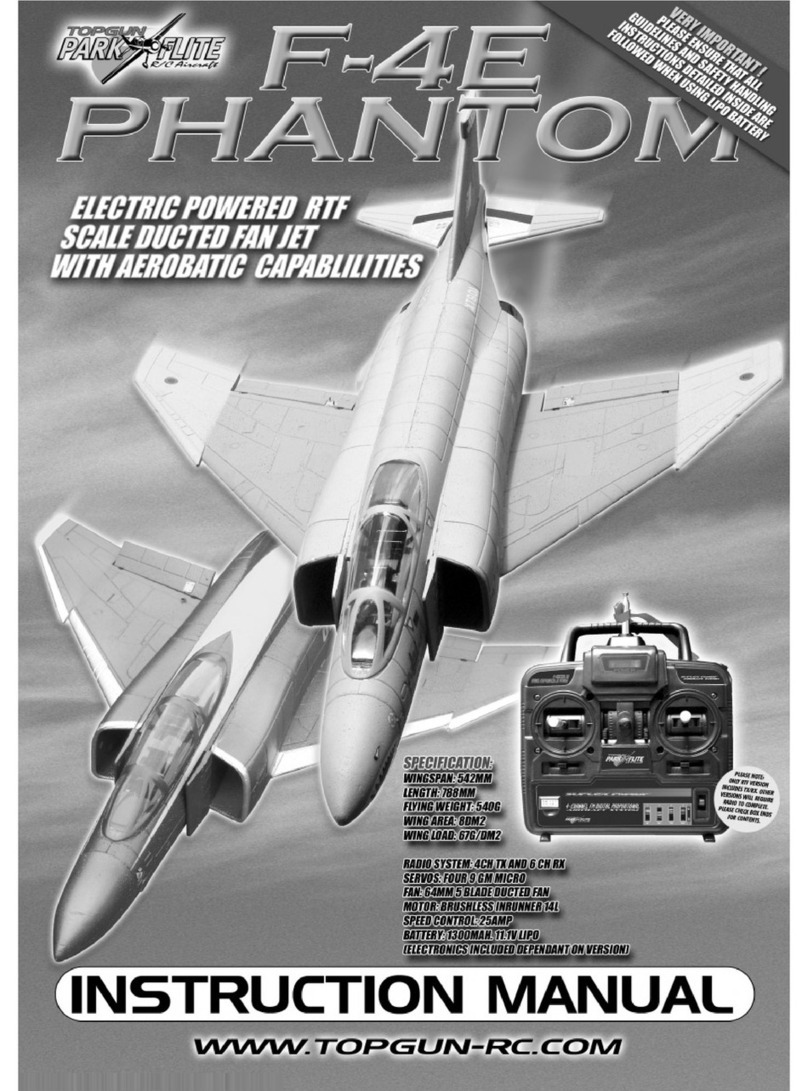
Top Gun Park Flite
Top Gun Park Flite F-4E Phantom instruction manual

SHARK JAW TOYS
SHARK JAW TOYS MAKO JET instruction manual
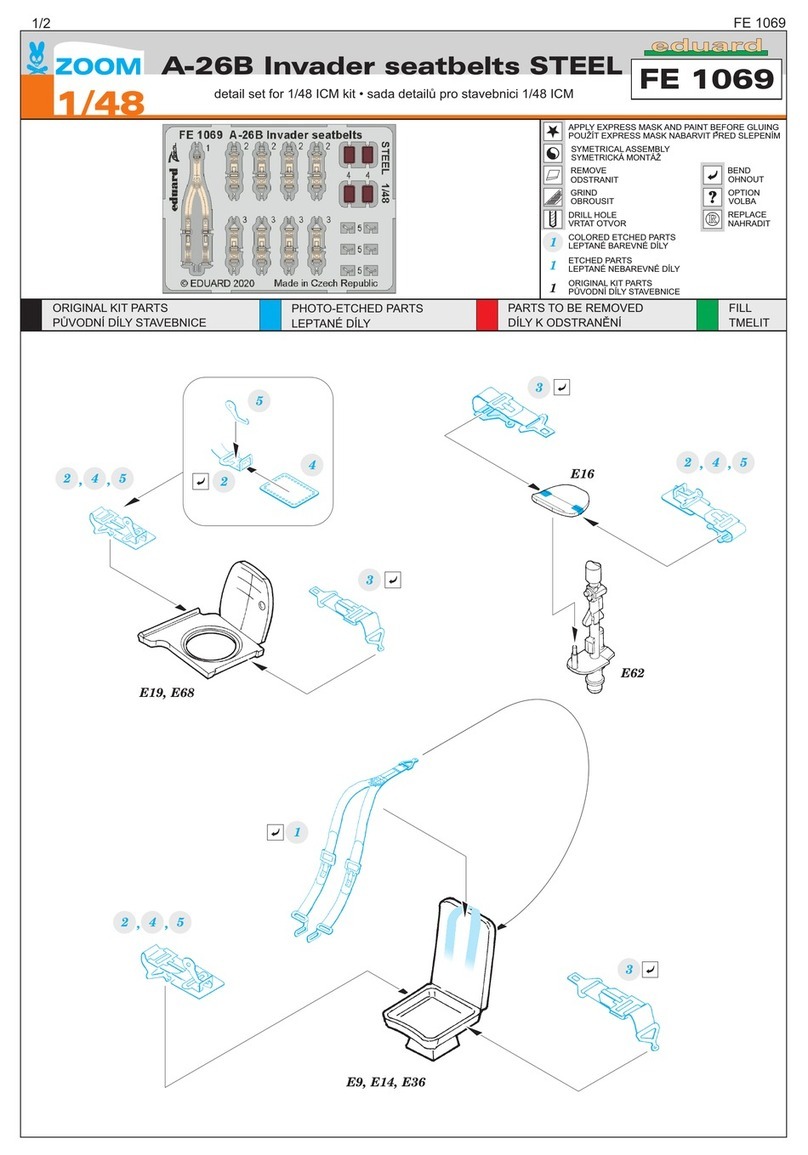
Eduard
Eduard A-26B Invader seatbelts STEEL manual
